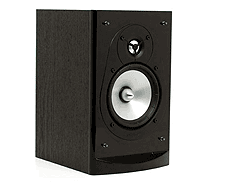


Once a part of the mighty Audio Products International in Canada, Energy Loudspeakers, now owned by Klipsch, has produced high quality, affordable loudspeakers since 1973. Rooted in a pile of research created together with Canada's famous National Research Council (NRC), Energy's R&D has always pushed the boundaries of affordable excellence, and kept the company at the forefront of its price classes.
Additional Resources
• Read more bookshelf speaker reviews from HomeTheaterReview.com.
• Learn more about affordable home theater from Managing Editor Andrew Robinson.
Located in the middle of its product line, Energy's Connoisseur series offers three bookshelf models, with the two-way CB-10 (MSRP $250 per pair) in the middle of the $350 CB-20 and $180 CB-5. The compact CB-10 measures 11.4 inches high by 7.1 inches wide by 8.5 inches deep, and weighs a solid 8.9 pounds. The design couples a 1-inch hyperbolic aluminum-dome tweeter to a 5.5-inch woofer utilizing Energy's patented Ribbed Elliptical Surround, which increases excursion and efficiency, according to the company (The phase plug in the middle of the CB-10's woofer is surrounded by a silver ring, as opposed to a gold ring in the CB-20. Didn't seem to make a difference.). The design uses a 2.8kHz crossover point, 600Hz higher than the CB-20. As with all of Energy's speakers, the CB-10 employs the company's famous Convergent Source Module (CSM), which, according to the company, lowers distortion while improving dispersion and midrange by placing the midrange and tweeter as close together as possible (this design also makes for an elegant cosmetic presentation on the baffle). As with the CB-20, the CB-10 employs a rear-firing port, and provides a handy foam port plug for each speaker to contour the bass response. The CB-10 also provides a single pair of gold-plated, 5-way binding posts, along with a ¼ -inch - 20 threaded insert for easy mounting. The CB-10's Black Ash vinyl finish wraps cleanly around the enclosure and looks terrific, especially when combined with the baffle's gloss black finish and silver drivers. The CB-10 looks as good as its big brother, and maybe even just a tad more so because of its smaller size. The dynamics of the different materials stand out even more with the smaller model.
Sound
The CB-10 presents a nominal 8 ohm load with a 90dB efficiency. The CB-10 performed well even with just good quality receivers and amplifiers. While its performance improved with better quality power, it didn't seem mandatory to get it performing optimally.
The CB-10 threw a reasonably deep, wide soundstage and imaged nicely. The sense of depth could have been a tad better, but overall it did a good job considering its compact size. The bigger CB-20 offered a very good tonal balance with great neutrality; this did not carry over quite as much with its baby brother. While the CB-10's top end offered many of the same fast, detailed qualities, it ran into a midrange that offered just a hint less warmth, bloom, and liquidity, especially on acoustic and vocal tracks. Moving downward, the lower mids and upper bass exhibited some solid punch and fairly good depth, but didn't have the well-rounded qualities of the CB-20. Certainly, the smaller woofer in the CB-10 can't be expected to perform like the bigger one in the CB-20, but the difference didn't just end there. The CB-10's lighter weight in the mids and bass stuck out a bit too much in contrast to its very good high end performance, and therefore didn't offer as much coherence and balance as the bigger model. This seemed to reveal itself more on bass heavy tracks, large orchestral material, and on some acoustic tracks where lower midrange bloom would have added some balance. And the foam plugs seemed to exacerbate this issue most of the time; the CB-10 sounded better without them. However, overall the CB-10 performed well when factoring in its price and size; these factors didn't impede my overall enjoyment of the speaker. It retains enough coherence and speed to cross the finish line as a good value.
Click to Page 2 for The High Points, The Low Points and The Conclusion.
 High Points
High Points
• The CB-10 offers a detailed, crisp sound quality with a good amount of pace and speed, especially on electronic tracks.
• The CB-10 utilizes a lot of high-end technology and offers terrific parts quality.
• The CB-10 looks superb, is put together like a rock, and offers a very small footprint.
• The CB-10's light weight and on-board mounting capability give it a lot of placement versatility.
Low Points
• The CB-10 offers a slightly lightweight tonal balance that comes up a
bit short with vocal and piano tracks, large orchestral and bass heavy
material.
• The CB-10 only comes in one finish (High gloss black baffle with black ash cabinet).
• The CB-10 only provides one set of binding posts, preventing bi-wiring/bi-amping.
Conclusion
The Energy CB-10 offers a decent amount of quality and value for its
low price. Its slightly lightweight presentation lowered its overall
musicality on material that requires some heft in the midrange and
bass. It just couldn't quite get down there and round things out a bit
more. Now while this certainly can't be strongly expected from such a
small speaker on a pure frequency response basis, this wasn't about
pure performance gymnastics as much as overall balance. And ironically,
if the CB-10 didn't perform so well on the top end, it might not have
showed as much. It must be noted, however, that these issues didn't
detract from the speaker's overall good performance and value
proposition. It's a very competitive product, and will very likely
appeal to hordes of people. It looks great, doesn't cost a lot, and
brings a lot of technology to the table. That's a pretty compelling
proposition.
Additional Resources
• Read more bookshelf speaker reviews from HomeTheaterReview.com.
• Learn more about affordable home theater from Managing Editor Andrew Robinson.